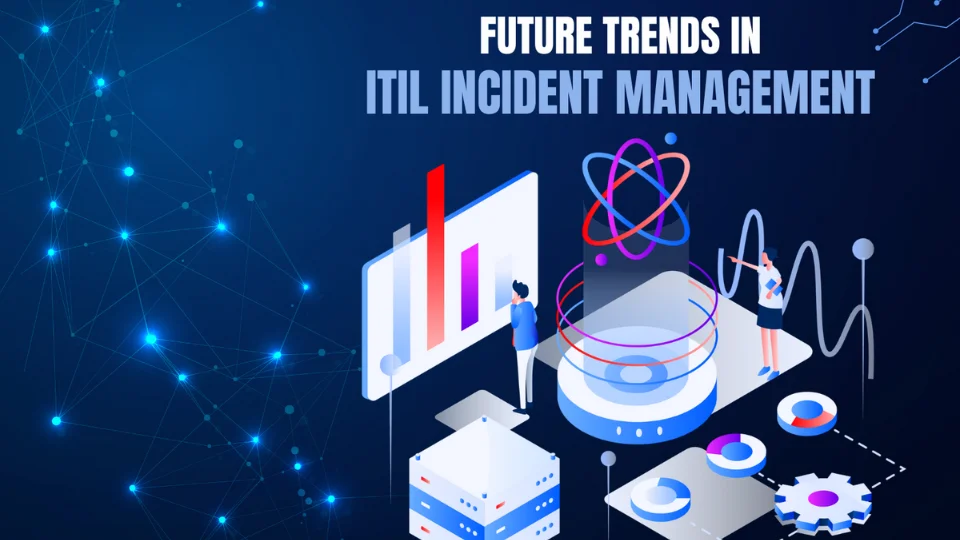Future Trends in ITIL Incident Management

Imagine a Monday morning when your company’s critical application goes down just as everyone logs in to start their week. Though considerable time and effort are lost, the IT team runs to find and fix the problem. How can you avoid these demanding circumstances and better control incidents in a digital landscape?
Efficient incident management depends on maintaining flawless operations and reducing disturbance in the digital environment. ITIL Incident Management is a model used nowadays to let companies effectively manage IT incidents. According to Axelos, over 85% of IT professionals agree that ITIL Certification has dramatically enhanced their incident management systems. But as technology advances, so must our incident management strategies.
This blog will explore upcoming ITIL Incident Management trends that could revolutionise how we handle IT disruptions.
Automation and AI Integration
Incorporating artificial intelligence (AI) and automation is a trend and a revolution in how incident management techniques are simplified. Driven by artificial intelligence, automation gradually invades daily tasks, including initial diagnosis, ticket routing, and even ordinary incident resolution. This change accelerates reaction times and lets IT experts concentrate on more complex issues needing strategic thinking and human involvement.
Imagine a situation in which an artificial intelligence system not only recognises and classifies an incident but also, depending on past data and patterns, offers the best feasible answer. These skills help incident management teams be more efficient, lowering downtime and raising the calibre of services.
Predictive Analytics
Predictive analytics promises to shape ITIL incident management in the future. Past incidents help companies forecast possible disruptions and act early to stop them. This strategy moves the emphasis from reactive to proactive management, lessening the effect of IT incidents on corporate activities.
Predictive analytics can help find trends before typical incidents. For instance, predictive technologies can notify the IT team to intervene before a server failure affects consumers if it usually results from specified circumstances.
Here’s a predictive analytics graph example that forecasts potential future incidents based on historical data. The solid line shows the actual number of incidents recorded each month, while the dashed line represents the predicted number of incidents, indicating a slight upward trend in the forecast.
Enhanced Use of Chatbots and Virtual Assistants
The priority is user experience, so ITIL Incident Management is increasingly using virtual assistants and chatbots to give end users immediate assistance. These tools are becoming more advanced and can manage a broad spectrum of user queries, from system problems to password resetting.
It is incredible that these virtual assistants learn from every connection and improve their handling of problems at the first touch. This increases user pleasure and lightens the burden on IT support employees.
Cloud-Based Incident Management Tools
Cloud-based tools provide flexibility, scalability, and accessibility not seen in conventional on-site solutions. By using the cloud, companies can guarantee that their incident management systems always have the most recent features and best practices, balancing the need for extensive and expensive updates.
Furthermore, cloud services can offer improved collaboration tools that let remote incident management teams operate effortlessly wherever they are. This is very helpful in work-from-home environments.
Here’s a line graph example demonstrating the scalability of cloud tools in handling increasing numbers of incidents over time. The graph shows a steady increase in the capacity of cloud tools to manage more incidents from 50 up to 500 over a two-year period. This visualization highlights the effectiveness of cloud-based incident management systems in scaling up to meet growing demands.
Focus on Security Incident Management
The need for strong security incident management inside the ITIL framework changes with the development of cyber threats. Deeper incorporation of cybersecurity techniques into incident management procedures seems to be the future trend. This implies reacting to security incidents and getting ready for them through continuous monitoring and immediate response systems.
Companies will progressively use a whole approach to security to make sure incident management teams have the tools and skills to properly handle and minimise security breaches.
Integration with Other IT Service Management Processes
Future trends point to a more integrated strategy, including Configuration Management, Change Management, and Problem Management, among other IT Service Management (ITSM) techniques. This integration helps guarantee that the underlying reasons are taken care of and future incidents are reduced, in addition to helping to manage incidents.
For example, lessons acquired in incident management can directly feed into problem management procedures, facilitating identifying and resolving reoccurring problems. Similarly, incident data helps change management evaluate the effects of current changes and enhance change policies.
Conclusion
With several changes redefining how companies handle issues, ITIL Incident Management has a bright future. From the acceptance of artificial intelligence and automation to the connection with DevOps techniques, these developments promise to increase efficiency, lower downtime, and improve user experience.
Therefore, understanding these future trends in ITIL Incident Management is essential regardless of your role. Let’s welcome these developments and steer towards incident management using The Knowledge Academy’s more proactive, user-centric, data-driven approach.











